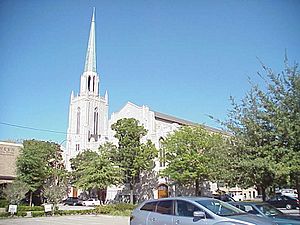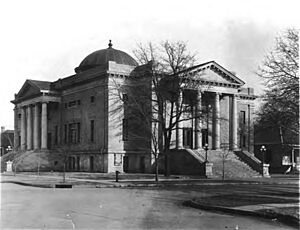First Presbyterian Church (Tulsa) facts for kids
Quick facts for kids First Presbyterian Church of Tulsa |
|
|---|---|

First Presbyterian Church, Tulsa in 2007
|
|
| Location | Tulsa, Oklahoma |
| Country | U.S. |
| Denomination | Presbyterian Church (USA) |
| Membership | 2,600 |
| Website | [1] |
| History | |
| Status | Church |
| Founded | 1885 |
| Founder(s) | James M. Hall |
| Architecture | |
| Functional status | Active |
| Architectural type | Gothic |
| Completed | 1926 |
The First Presbyterian Church in Tulsa, Oklahoma, started way back in 1885. This was before Oklahoma even became a state! It began in a store owned by two brothers, James M. Hall and Harry C. Hall. At first, traveling ministers would visit to lead services.
Their first church building was made of wood and built in 1899. A permanent minister, Reverend Charles William Kerr, arrived in Tulsa in 1900. He stayed for over 40 years! Under his guidance, the church built two more stone buildings.
As Tulsa grew into a big city because of the oil boom, this church also grew. By 1948, it was the second-largest Presbyterian church in the whole country! Today, it is part of the United Presbyterian Church in the USA.
During a difficult time in Tulsa in 1921, Reverend Kerr opened the church. He offered a safe place for African Americans, mostly women and children, who were escaping violence in their neighborhood. The church building from 1926 is now part of the city's Oil Capital Historic District. This district was added to the National Register of Historic Places in 2010.
Contents
History of the Church
How the Church Started (1880s to 1910)
In 1882, two brothers, James M. Hall and Harry C. Hall, opened a store in Tulsa. Tulsa was then part of the Creek Nation in Indian Territory. Traveling Presbyterian missionaries visited the town. Their salaries were paid by the Presbyterian Church of the United States of America. Reverend Robert McGill Loughridge gave the first sermon in Tulsa on August 19, 1883. He preached on the porch of the Hall brothers' store.
The small group of churchgoers asked Reverend William Penn Haworth to be their pastor. He was a missionary in another town called Vinita. Reverend Haworth helped get money from the Presbyterian Church to build Tulsa's first schoolhouse. This building also served as Tulsa's first church. James Hall is known for starting the First Presbyterian Church (FPC). It was the first permanent Protestant church in Tulsa. Meetings began in 1885 at the Presbyterian School House.
The church congregation grew, so FPC moved to a new building in 1899. It was a wooden building at 4th Street and Boston Avenue. In 1901, Reverend Charles William Kerr became the second minister. He was a very energetic leader. The church grew quickly because many people were moving to Tulsa. This was due to the discovery of oil nearby in 1901 and 1905. Other churches also started in Tulsa around this time.
James Hall and two friends also started the Union Sunday School. This was a Sunday school for different Christian groups. Hall was the superintendent of the FPC Sunday school for twenty years.
Growing and Helping Others (1910 to 1926)
In 1910, the church moved to an even newer building. It was a three-story limestone building at Seventh Street and Boston Avenue. It had a round, domed roof and tall columns. This building was later taken down in the early 1950s. The Kerr Building stands there now.
In June 1921, there was a difficult time in Tulsa. Reverend Kerr of FPC opened the church basement to help people. He gave shelter to African-American women and children. They were seeking safety from violence in the Greenwood District.
A Big Church (1926 to 2010)
The third permanent church building was finished in 1926. It was built next to the 1910 building. Mrs. Kerr called this Gothic-style church the "high kirk" of Tulsa. You can see this building in the 2007 photo at the top of this page.
In 1928, the main meeting of the Presbyterian Church in the USA was held at FPC, Tulsa. In 1932, Reverend Kerr was chosen to lead this big meeting.
Reverend Kerr retired as the Senior Pastor in 1941. He continued to serve as Pastor Emeritus until he passed away. By 1941, the church had more than 3,200 members. It kept growing under the next pastor, Dr. Edmund Miller, to over 5,000 members. In 1948, the church was officially named the second-largest Presbyterian church in the United States.
The 1910 church building was taken down in the early 1950s. The current C. W. Kerr Building was built in its place. It was named after the long-serving pastor.
Modern Times (2010 to Present)
In 2010, FPC started building a new expansion. This new area is between 7th and 8th streets and Boston and Cincinnati avenues. The project included updating the old church building on Boston Avenue. It also added new offices, classrooms, and a courtyard shaped like a Celtic cross. There is also a new large space for worship and community events. This new complex cost $33 million.
In December 2010, the 1926 church building was recognized as an important part of the Oil Capital Historic District. This district is listed on the National Register of Historic Places.
Pastors Who Led the Church
- Charles William Kerr, 1900 - 1941
- Edmund F. Miller, D. D., 1941 - 1957
- Bryant M. Kirkland, D. D., 1957 - 1962
- William Wiseman, 1963 - 1984
- Ernest J. Lewis, 1985 - 1990
- James D. Miller, Ph. D., 1992–2023
Current Pastors
- Rev. James D. Miller, Ph.D.
- Rev. James Estes, M.Div.
- Rev. Wambugu Gachungi, M.Div
- Rev. Dan Hutchinson, M.Div.
- Rev. Julia Metcalf, M.Div.


